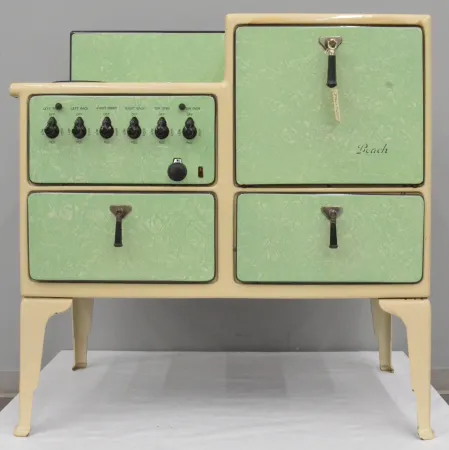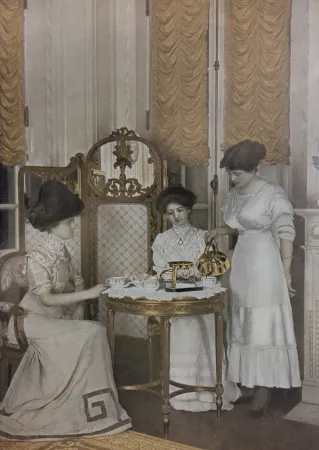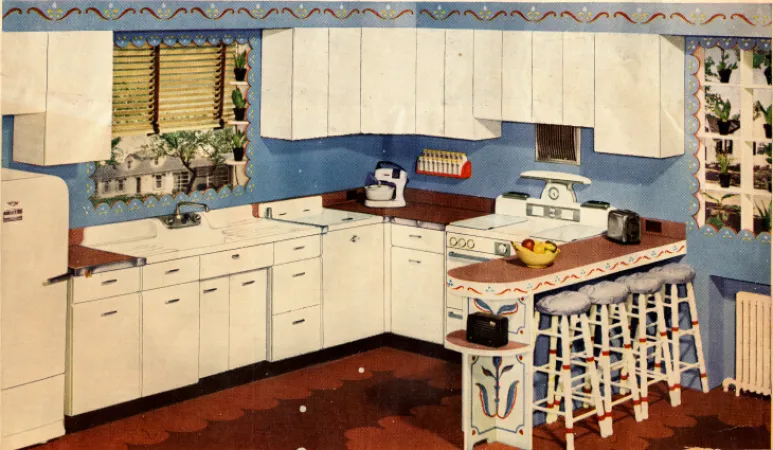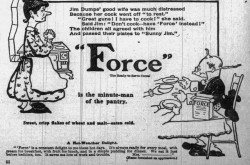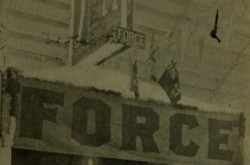From the Stove to the Electric Range: The Range Collection
The Ingenium’s collection of ranges, includes a variety of appliances — fireboxes, table stoves, cooking plates, buffet stoves — and illustrates the main innovations made to these electric household cooking appliances between 1900 and 2000.

Fawcett stove, 1919
The terms stove and range are used interchangeably in Canada. The term stove has a broader range of meanings including both cooking of food, and heating of the home.
The term range is more likely to refer specifically to a cooking appliance; it has become more common in recent years, particularly in upscale kitchen design and decorating.
Electric cooking appliances were first manufactured in Canada in the 1920s with the consolidation of the system for producing, transforming and distributing electricity. Electrification facilitated use of these appliances first in the city, in upper-class households, and then gradually in rural regions.
After the Second World War, the population boom, urbanization, changes in housing and promotion by manufacturers were all factors that contributed to the expanded production and distribution of electric ranges in Canada. At the same time, advertising and industrial design were new tools being used to convince Canadians to become keen consumers of these new appliances that would literally change their way of life.

The Hall, Zryd Foundry Co. Ltd, Hespeler, Ontario
Ranges were first manufactured in foundries using traditional methods. Later, they were built on factory assembly lines. Made from a variety of materials, the fabrication of ranges is one of the best examples of the formation of spinoff industries. The growth of the Canadian industry in the electrochemistry, electrometallurgy and steel sectors from the 1920s, and in petrochemistry after 1947, led to the production of polymers, acrylics and plastics, as well as ceramic and aluminum composites, all of which were used in manufacturing electric household appliances. Despite the availability of American technologies, the Canadian electric range industry developed steadily beginning in the 1930s.

Preparing dinner on a wood stove in the First House, St Jean-Baptiste MB
In the nineteenth century, kitchen stoves were generally fuelled by wood, especially in rural areas with abundant woodlands. In large cities coal and coal gas became available in the 1830s. This facilitated the use of coal gas stoves, particularly in upper-class households.

Enterprise Foundry Company, 1890 coal stove
Efficient wood or coal stove cooking required tree species and carboniferous material that provided good combustion, as well as continual feeding of the oven to avoid temperature fluctuations. In addition to spreading dust and debris, stoves of the era were difficult to maintain because they became very hot, and, they required that the kitchen be arranged around the chimney. Even though the coal gas stove controlled heat better, it released smoke that would spread throughout the house, through gaslights affixed to ceilings or walls.

Corona range advertisement, 1920
Around the 1920s, advertising for electric ranges showed how easy they were to maintain: they did not give off smoke or foul odours and prevented food from sticking to pots and pans. Deemed more economical and reliable than servants, these ranges enabled the hostess to spend more time in the company of her family or guests. Preventing illness from food-borne bacteria and conserving the nutritional value of food were also among the virtues of cooking with electricity. Undoubtedly, concerns about cleanliness and hygiene resulted from the unsanitary state of homes following mass industrialization, and were perhaps inspired by the architect Le Corbusier, who recommended to “put the kitchen at the top of the house to avoid smells.”
In the nineteenth century, ironmasters, including Joseph Van Norman of Normandale Iron Works in Long Point, Ontario, James Rogers Armstrong of the Toronto City Foundry, and Henri Bernier of the fonderie Bernier in Lotbinière, obtained patents for the manufacture of cooking ranges. Ranges from the Montreal Foundry and City Works, A. Bélanger Limitée in Montmagny, the Gurney Foundry Company Limited in Hamilton, and the McClary Manufacturing Company in London, were highly praised.

Guelph Stove Company, 1909
The traditional design of a wood stove produced by the Guelph Stove Company around 1909 made it possible to separate the cooking and warming of food. This stove includes compartments to burn fuel and gather ash, and an oven that supplies the heat to the cooking plates. Once cooked, food could be placed in the food warmer in the upper section.
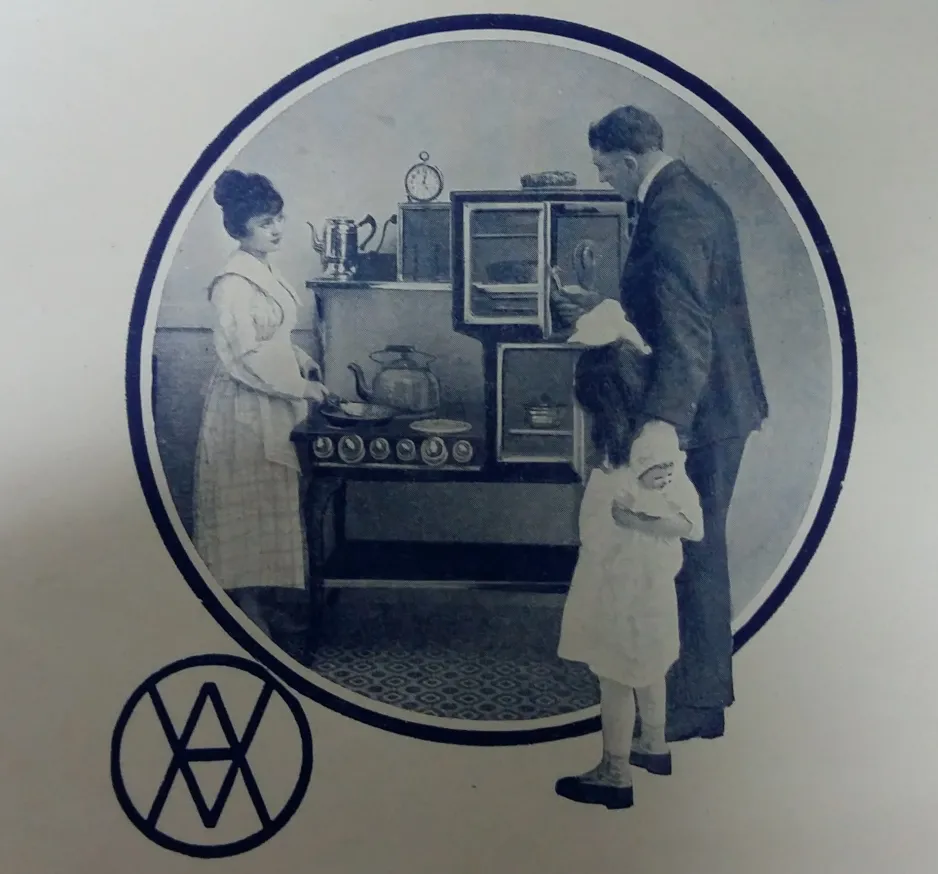
Canadian Westinghouse Company Limited catalogue, 1919
In the 1920s, the gradual spread of electrification in Canada favoured the expansion of industries specializing in the manufacture of equipment for hydroelectric and lighting installations, and the electric household appliance industry followed this trend. Electric ranges were manufactured by the Canadian Westinghouse Company Limited and the Canadian General Electric Company Limited, subsidiaries of American companies.

Logo for General Steel Wares Limited
Established in Toronto in 1927, General Steel Wares Limited combined small workshops in Ontario and Quebec that, since the nineteenth century, had been well known in the production of stoves and kitchen implements: McClary Manufacturing Company in London, Happy Thought Foundry Company in Brantford, Thomas Davidson Manufacturing Company Limited in Montreal, Sheet Metal Products Company of Canada Limited in Toronto, A. Aubry et fils Limitée in Montreal, and, E. T. Wright Limited in Hamilton. Beatty Brothers in Fergus, and Moffats Limited in Weston joined the group in 1961 and 1971 respectively. In 1977, the merger of this consortium with General Electric Canada Incorporated and Westinghouse Canada Limited led to the formation of the Canadian Appliances Manufacturing Company Limited (Camco), which today remains one of the main manufacturers of electric household appliances in Canada.

Gurney–Northern Electric catalogue
From 1920 to 1940, the Northern Electric Company Limited joined with the Gurney Foundry Company to produce and distribute electric ranges. A similar association brought together the General Motors Corporation and Frigidaire Home Products from the 1930s to the 1970s.

Thomas Ahearn's patent for an electric oven, 1892
The first leaders of the electrical industry in the Ottawa area, Thomas Ahearn and Warren Y. Soper, owners of the Chaudière Electric Light and Power Company since 1887, launched a charm offensive to promote the use of electricity for cooking. In 1892, they prepared a meal at the Windsor Hotel in Ottawa using an oven, a warming bottle and a food warmer designed and manufactured by Thomas Ahearn using patents he had obtained earlier that year.

Canadian Beauty range, 1920
The challenge in developing an electric range lay in maintaining a balance in cooking temperature: high enough to roast meat, but not so high as to burn other foods. Manufacturers combined two base units: a square box (the oven), to grill and cook food at high temperatures and, above it, a cooking plate on which pots and pans could be placed to simmer food at lower temperatures.

Hotpoint Calrod burners, 1960
The shape and structure of cooking plates evolved over the years to be either open or closed, and roughly fifteen to twenty centimetres in diameter. Initially, open cooking plates had wires coiled in a mould inside a ceramic disc, and there were three temperature settings: low, medium and high. However, the uneven heating of the cooking plate, the variation in size and shape between the cooking plate and pots and pans, and splashes of grease and liquid, caused the elements to break down regularly. In the 1930s, a drip pan placed below the open plate to catch grease and liquid spills from the cooking surface was adopted widely. Meanwhile, the Calrod element, marketed by Hotpoint during the same period, was made from an aluminum and steel alloy, thus making it better able to withstand high temperatures as well as damage from humidity and oxidation.

Nichrome burner
Initially, closed cooking plates were made from nichrome wires placed inside an iron disc or wrapped between insulating sheets made from mica. However, the instability of the wires and disintegration of materials caused power failures. Around 1913, General Electric developed a process to strengthen the wires by insulating them with magnesium oxide then sheathing them in pressed steel.

Cooking plate, Simplex Electric Company, circa 1908
The Simplex cooking plate, produced around 1908, consists of a ten-centimetre cast-iron disc mounted on a saponite support used as a non-conducting element. A ceramic lever controls three heat settings. The lug is characteristic of the era, when electric wall outlets were rare in homes. Limited functions, the fragility of the elements and poor electrical output eventually led to the appliance’s disappearance from the market around 1917.

Range, Simplex Electric Company, circa 1910
Most likely created from various components with independent functions, the small Simplex electric range, though manufactured around 1910, illustrates the models produced in foundries in the nineteenth century, with a cast-iron box accommodating the oven. However, the overall construction heralded modern features, including the double-walled oven insulated with asbestos, a heating surface about eight centimetres above it, porcelain control knobs, and three disc-shaped nickel-plated copper cooking plates, the largest of which could be used as a griddle, and a grill for meat or bread, each plate having fasteners to secure cooking pots. This arrangement facilitated cleanup and no doubt contributed to the appliance’s popularity.

Buffet range, Copeman Electric Stove Company, circa 1912
Covered in asbestos and rolled metal, the wood-construction Copeman buffet range, manufactured around 1912, is topped with two closed ceramic heating plates each containing a nichrome element. Innovations included aluminum panels to insulate the oven, and thermometers to measure the heat produced.
During the 1920s, 1930s and 1940s, when the use of electricity gradually became widespread in urban centres and rural areas, it is estimated that from 700 000 to over one million Canadian households used electricity. The country’s population was only eight million at the time. Cooking appliances of various shapes and functions were marketed: small table stoves, huge ranges combining electricity and wood or coal, and elegant buffets in various colours. Among the novelties of the time were hermetically sealed enamelled ovens and the ceramic power supply.

Table stove, Armstrong Manufacturing Company, 1922
The electrification of the Roaring twenties kitchen was often depicted in the fully electric breakfast, with a percolator, toaster, warming plate and portable stove all set out on the table. Made from pressed steel, nickel, aluminum and porcelain, the Armstrong table stove could poach eggs and grill meat, bread or waffles. Since it radiated heat and thus complemented a wood or coal stove in heating the room, it remained popular in many homes until the late 1940s.

Hot plate, Triplex Electric Manufacturing Company, 1922
Another appliance also used for both ambient heat and food cooking, a hot plate from 1922, in the shape of a basket, combines two cast-iron sections attached in the middle with hinges. Arranged horizontally, they provide two knob-controlled hot plates, while vertically, they form a radiator on feet.

Electric buffet range, Beach Foundry Limited, circa 1937
Cooking and warming ovens arranged side-by-side, along with vertical control knobs, altogether creating an aesthetically pleasing design, heralded the classic style of the Beach buffet range. The construction of this new appliance in green and ivory marbled porcelain, the hidden bolts, and the hinged cover that could be swung up against the wall to create a backguard, were signs of modernity, while the short cast-iron feet were reminiscent of old wood stoves. Uniform cooking was assured by closed cast-iron plates covering nichrome elements.

Electric range, Findlay Brothers Company Limited, circa 1930
Very large ranges combining different energy sources were in vogue in the 1930s. The Findlay range, with bolts very much in evidence, combined two stacked fireboxes on the lower left, and a wood- or coal-fired oven intended for home heating above them. The right-hand side of the appliance was electrified and contained an enamelled porcelain oven (lower right) and food warmer above. With nichrome open cooking plates resting on trays, the range was considered innovative. Manufacturers stressed the ability of these ranges to use various fuel sources, enabling them to continue to function during electric power outages.

Electric range designed by Raymond Loewy, Frigidaire Home Products, late 1940s
Raymond Loewy (1893–1986), a Franco-American designer, is known for his creation of the Coldspot refrigerator in the mid-1930s. From 1939 to 1955, he worked for Frigidaire Home Products, a branch of the General Motors Corporation at the time. Working with company engineers, he used patterns from the automobile industry to design lighter-weight ranges that would be easier to use and maintain. The result can be seen in one piece from the collection, a white enamelled metal stove trimmed with chrome handles, stovetop element rims, and lamp shell. The standardization of the width at forty inches (about one metre) and the increased accuracy of the heat controls to within five degrees Fahrenheit, were the main technical innovations of this model, manufactured at the end of the 1940s.

Electric range designed by J. M. Little, Canadian Westinghouse Company Limited, circa 1950
A Westinghouse range designed by J. M. Little illustrates the harmony between materials, arrangement of components, and accessories. The rounded corners and the food warmer evoke earlier styles, but modern design is evident in the height of the backguard, the concentration of the control knobs, and the electrical outlet with a timer. As in Loewy’s Frigidaire model, the work space to the right of the cooking surface prefigured the counters that would soon furnish kitchens.
Mass construction of apartment buildings, associated with urban growth in Canada in the 1960s, imposed a homogeneity in home layout in which form followed function. The kitchen occupied a small space, combining kitchen cupboards, counters and electric household appliances, and was used exclusively for preparing food, while meals were usually eaten in the larger dining room. Having the kitchen adjoin this area made it easier for hosts and guests to communicate.

Range, Canadian General Electric Company Limited, circa 1960
Representative of the era, the Canadian General Electric Company range is distinguished by its bright colour, narrower thirty-inch (seventy-six-centimetre) width, single oven and its accessories — pushbutton controls, exterior light, clock and timer.

Range, Tappan–Gurney Limited, circa 1964
The automation of components and accessories also marked the 1960s, as shown in the Deluxe Tappan–Gurney range.This range has retractable heating elements, controlled by knobs with seven heat settings, and an instrument panel controlling the rotisserie, lamp, and grill in the upper part of the oven. The lazy Susan in the lower section completes its features.

Range, Whirlpool Corporation, 2003
Ranges available at the end of the twentieth century had the same shape, size and voltage standardized in the 1960s, but heralded innovative materials. Equipped with a glass cooking surface, marked with circles to indicate the location of the elements beneath, a 2003 Whirlpool model is distinguished by the electronic control of both cooking and self-cleaning functions, built-in oven grills and utensils, an anti-tip bracket, and the specialized four-pronged plug to fit the outlet required for high voltage appliances.



